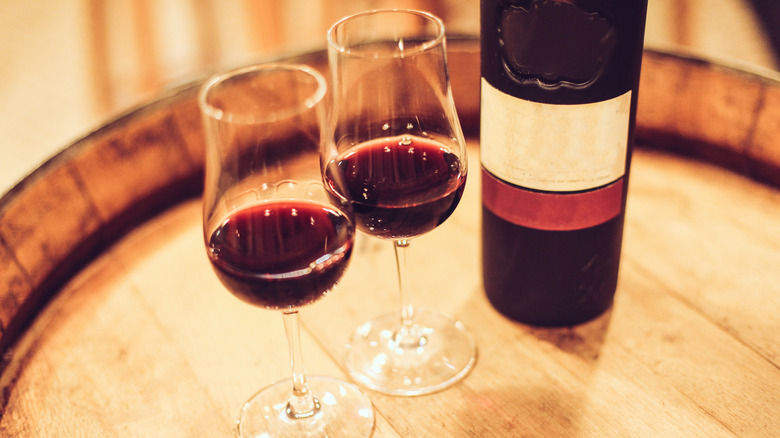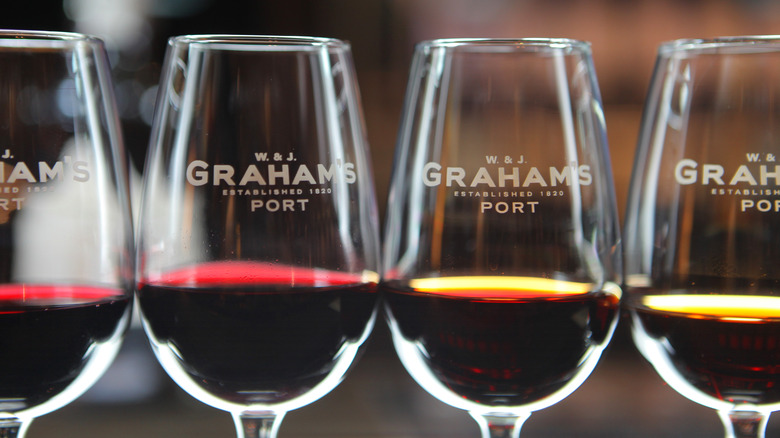Tawny Vs Ruby Port: What's The Difference?
There's always an occasion for a port. These Portuguese fortified wines are a full-bodied, sweet, and comforting drink that fares especially well during the winter season. And while the different port types — white, ruby, and tawny — share many similarities, such as how they're made and the food they pair well with, these wines shouldn't be confused.
Port is a type of fortified wine, which is made by adding a distilled spirit. The ports aren't any old fortified wine, however: They are produced with grapes from the Douro Valley in the northern part of Portugal. The spirit of choice is usually a grape brandy, and its addition halts the fermentation process, resulting in higher sugar content, as well as a higher ABV. These wines are, predictably, sweet, and as such pair well with artisanal cheeses and various types of desserts. White port is made with very specific grapes and is the least common of the three main types: you're far more likely to encounter ruby and tawny port.
Some say the best things are created by accident, and that's definitely true of port, which was invented when two British brothers fortified wine with grape brandy, a process that yielded surprising results. They were making a long journey, transporting Portuguese wine to Europe, and thought that adding the spirit to the wine would help to maintain its quality, per Ricks Steves Europe. It was a hit, beginning a long tradition of the Portuguese fortified wine. So what's the difference between ruby and tawny port? It all comes down to age, color, and flavor.
Ruby ports are red and sweet
You'll notice one big difference between ruby and tawny ports at first glance: True to the name, they are a deep ruby-red hue. They're also younger than tawny ports — even vintage ruby ports are aged for only a few years, which is why the wines keep their red color. The different varieties of ruby ports are classified based on how long they've been aged and how they're bottled; higher quality "reserve" varieties typically have a higher price point than the younger, simple ruby ports. As with regular wine, the aging process affects the flavor as well.
Ruby port is a fortified wine that is aged in large oak barrels or stainless steel vats, which maintains the natural grape taste. This is because the wine has minimal contact with the container and oxygen, which means its flavor and color don't change as much as tawny ports do. Ruby ports are sweeter and fruitier, pairing well with desserts, especially fruity desserts with raspberries or mixed berries. Ruby ports also pair well with chocolate and soft-ripened cheese, such as gorgonzola. The wine has notes of raspberry, cherry, and plum, and many notice its intense fruity aroma.
Tawny ports are more complex
Tawny port is ruby port's more complex counterpart. Also true to its name, tawny ports are more mahogany in color. The wine is aged for long periods of time in small oak barrels, and the increased contact with the oak and oxygen results in color and taste changes (because with larger barrels, a smaller percentage of the wine is touching a surface). Some tawny ports are aged in wooden casks as long as 40 years! This aging process refers to the time spent in the oak barrels — tawny ports aren't intended to age after bottling.
The longer the wine ages, the more complex of a flavor it develops, which is another difference between the two ports. The wine also changes color as it ages, with more brown hues arriving as the years go by. The fortified wine is more chocolatey and nuttier than ruby ports, which means they pair well with desserts such as pecan pie and cheesecake. The more complicated and intense the dessert is, the better it will pair with older tawny.


